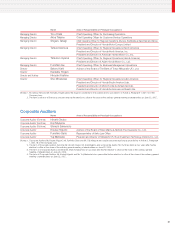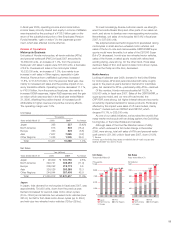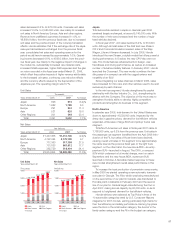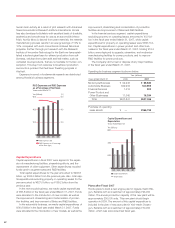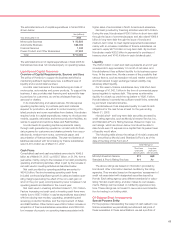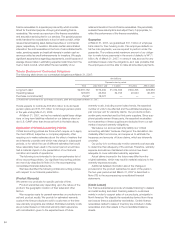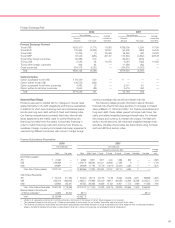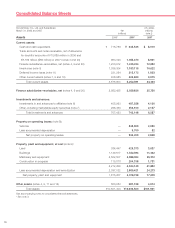Honda 2007 Annual Report Download - page 63
Download and view the complete annual report
Please find page 63 of the 2007 Honda annual report below. You can navigate through the pages in the report by either clicking on the pages listed below, or by using the keyword search tool below to find specific information within the annual report.
61
development of regional products at its overseas locations. At
the same time, we focus on developing industry-leading
technologies that address safety and environmental issues.
Breakthroughs during fiscal 2007 include the development
in the United States and Canada of the Gold Wing touring bike
equipped with the world’s first motorcycle airbag system. In
North America and Europe, the CBR600RR underwent a full
model change, achieving lower weight than the previous model
through a more compact engine installed in a newly designed
Fine Die-Cast aluminum frame. It also employs a newly
designed compact, electrically controlled steering damper that
facilitates further enhanced riding performance. In Asia, we
began production and sales at an equity-method affiliate in
India of the Glamour-FI 125cc motorcycle, equipped with a
PGM-FI electronic fuel-injection system, which meets new
demands for low fuel consumption and clean performance
through exhaust emissions. In China, we commenced produc-
tion and sales at an equity-method affiliate of two new models:
CBF150 motorcycle, mounted with a newly developed Core 2
150cc engine with low fuel consumption and robust power
achieved through substantially reduced friction loss and
improved cooling performance; and SCR110 scooter, which
employs PGM-FI low-friction technologies to become the first
model in the country to clear Euro3 motorcycle emission gas
standards.
Other technological R&D highlights include the announced
development of Honda’s Variable Cylinder Management (VCM)
system, which is based on high-performance Variable Valve
Timing and Lift, Electronic Control (VTEC) technologies for
three-phase control over the number of active cylinders, facili-
tating low fuel consumption and high power capacity. We also
developed an engine that offers one of the world’s lowest levels
of friction, achieved by improving fuel efficiency through a two-
plug system and reducing mechanical resistance in the engine.
Research and development expenses (which do not include
research and development at equity-method affiliates
described above) in the Motorcycle Business segment in
fiscal 2007 totaled ¥90.1 billion.
Automobile Business
In the Automobile Business segment, we strive to develop
innovative technologies and products through creativity-
oriented development in response to customer needs. We also
actively develop technologies that address environmental
issues and provide enhanced safety performance.
Major achievements during the year include a full model
change for the CR-V in markets around the world. For four-
wheel drive models, we introduced a new real-time 4WD
system that improves rear-wheel torque transmissibility by bol-
stering the existing dual-pump system with a one-way cam
unit. In Japan, we melded steering maneuver and voice guid-
ance in the Honda Smart Parking Assist System, which is used
on the Life. Further, we released the Crossroad, an automobile
that transcends existing categories by combining the design
and functionality of an SUV, the convenient size of a compact
car, and the three-row, seven-seat configuration of a minivan.
In North America, we commenced sales of the Acura RDX
entry-premium SUV, which features a newly developed 2.3-liter
i-VTEC (intelligent VTEC) turbo engine and Super-Handling All
Wheel Drive (SH-AWD) to provide good fuel economy, high
output and excellent driving performance. Breakthroughs in
other regions included sales of flexible fuel vehicle (FFV) ver-
sions of the Civic and Fit in Brazil that can be powered by
ethanol or an ethanol-gasoline mixture.
Another technology development milestone was the devel-
opment of a clean diesel engine on par with a gasoline engine
for environmental performance. This is achieved through a
newly developed NOx catalyst that efficiently purifies NOx
gases to nitrogen through a reduction reaction using ammonia
produced within the catalytic converter. In addition, we have
developed an evolutionary VTEC engine with high power and
low fuel consumption and emissions, attained by combining
VTEC and Valve Timing Control (VTC)—which dynamically
controls the intake valve lift amount and aperture angle—for
continuously variable control.
In the field of automotive fuel cell technologies, Honda
announced the operation of its next-generation fuel cell-
powered FCX Concept, with the compact, high efficiency
Honda FC STACK run through the central tunnel, to deliver
radically improved performance in terms of driving, as well as
environmental performance.
Research and development expenses in the Automobile
Business segment in fiscal 2007 totaled ¥447.0 billion.
Power Product and Other Businesses
In the Power Product Business, we seek to develop products
that match customers’ lifestyles and needs while strengthening
our lineup of offerings that address environmental issues.
In fiscal 2007, BF90 four-stroke marine outboard motor
underwent a full model change. This motor features such intelli-
gent technologies as a VTEC structure based on a 1.5-liter
passenger car engine, PGM-FI, a Lean Burn Control system
and the world’s first air-fuel timing ignition control for a marine
outboard. The BF90 is lightweight and compact, while achiev-
ing excellent drive performance and economizing on fuel
consumption. We also carried out a model change for our
compact, home-use cogeneration system, scoring improve-
ments in power generation efficiency and reducing the CO2
emissions ratio. An electronic control variable jet to automati-
cally optimize fuel flow is also employed to enhance cold-start
performance.
Other technical development spawned a high-expansion-
ratio engine with an original intake/compression stroke and
expansion/exhaust stroke structure that was prototyped during
fiscal 2007.
In other businesses, ongoing research into jet engines and
HondaJet, our advanced, compact business jet, has reached
fruition with development moving toward commercial
production.
Research and development expenses in this segment in
fiscal 2007 amounted to ¥14.6 billion.
Fundamental Research
In the area of fundamental research, Honda pursues steady
and varied research activities into technologies that may lead to
innovative applications in the future.
During the year, we announced a new brain-machine inter-
face creating basic technology for manipulating robots using


